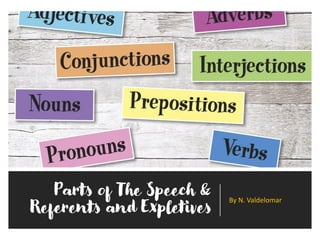
The Parts of The SpeechPP.pdf
- 1. Parts of The Speech & Referents and Expletives By N. Valdelomar
- 2. Parts of Speech Traditional grammar usually classifies words based on eight parts of speech: nouns, adjectives, adverbs, verbs, pronouns, prepositions, conjunctions, and interjections.
- 3. Building blocks of a language • Luisa read. • Luisa read a book. • Luisa read a book yesterday. • Luisa read a book to him yesterday. • Wow! Luisa wrote and read a book to him yesterday.
- 4. Why should we know the parts of speech? To understand grammar explanations. To use the right word form in the right place. To find the correct word in the dictionary.
- 5. Knowing the different parts of speech can be very helpful in improving your understandin g of a text. It can help you to… - infer a word’s meaning based on the context - determine the word’s importance within the sentence. - have clues to see how words relate to each other and make sense of what you are reading.
- 6. NOUNS • A noun is a naming word. It names a person, place, thing, idea, living creature, quality, or action. Examples: cowboy, theatre, box, thought, tree, kindness, arrival
- 7. VERBS • A verb is a word which describes an action (doing something) or a state (being something). Examples: walk, talk, think, believe, live, like, want, am, was
- 8. ADJECTIVES • An adjective is a word that describes a noun. It tells you something about the noun. Examples: big, yellow, thin, amazing, beautiful, quick, important
- 9. ADVERBS • An adverb is a word which usually describes a verb, an adjective, or another adverb. It tells you how something is done. It may also tell you when or where something happened. Examples: slowly, intelligently, well, yesterday, tomorrow, here, everywhere
- 10. Pronoun A pronoun is used instead of a noun, to avoid repeating the noun. Examples: I, you, he, she, it, we, they Conjunction A conjunction joins two words, phrases or sentences together. Examples: but, so, and, because, or Preposition A preposition usually comes before a noun, pronoun or noun phrase. It joins the noun to some other part of the sentence. Examples: on, in, by, with, under, through, at Interjection An interjection is an unusual kind of word, because it often stands alone. Interjections are words which express emotion or surprise, and they are usually followed by exclamation marks. Examples: Ouch!, Hello!, Hurray!, Oh no!, Ha!
- 11. Pronouns What is a Pronoun? A pronoun is a word used in place of a noun or noun phrase. Pronouns usually refer to something that was already mentioned in a previous sentence or understood by the listener or reader. They are very useful words because when you use them, you do not need to repeat nouns all the time. Without pronouns: Alex is my neighbor. Alex says that Alex likes to sleep. The wife of Alex gave Alex a new bed. With pronouns: Alex is my neighbor. He says that he likes to sleep. His wife gave him a new bed.
- 12. Subject Pronouns Object Pronouns Possessive Adjectives Possessive Pronouns Reflexive Pronouns 1st person I me my mine myself 2nd person you you your yours yourself 3rd person (m) he him his his himself 3rd person (f) she her her hers herself 3rd person (n) it it its (not used) itself 1st person (pl.) we us our ours ourselves 2nd person (pl.) you you your yours yourselves 3rd person (pl) they them their theirs themselves Pronoun test : ___ will go. Max saw ___. That's ___ name. The car is ___. (subj) saw (reflx) in the mirror.
- 13. Referents • When a pronoun replaces a word (or a group of words), the word being replaced is called an antecedent or referent. Example: I wrote a letter to the president, who responded quickly. In that sentence, president is antecedent of the pronoun who. • A pronoun must agree with its antecedent in person, number, and gender.
- 14. Expletives The word expletive comes from the Latin verb explere which means “to fill.” Expletives are words that perform a syntactic role but contribute nothing to meaning. That means that an expletive has a grammatical function but does not have semantic content. • IT • THERE
- 15. IT as a referent • “IT” is a referent when it refers to a noun that was already mentioned Example: I saw a shooting star. I saw it crossing the night sky. IT as an expletive • “IT” is used in impersonal sentences that require, for grammatical reasons, a subject at the beginning. It does not refer to previous subjects. Example: It is raining.
- 16. THERE as a referent “THERE” is a referent when it designates a place. Example: I saw my cat sleeping by the window. She was there. THERE as an expletive When “THERE” is part of the formula THERE + aux. + S, which designates the existence of a subject, it is an expletive. Example: There is a cat sleeping by the window.